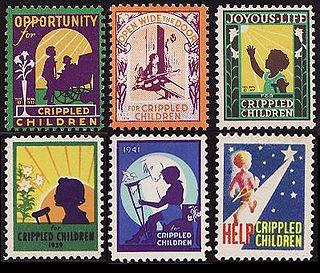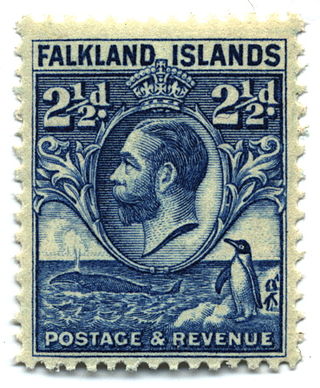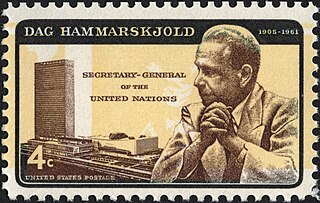Related Research Articles

A postage stamp is a small piece of paper issued by a post office, postal administration, or other authorized vendors to customers who pay postage. Then the stamp is affixed to the face or address-side of any item of mail—an envelope or other postal cover —which they wish to send. The item is then processed by the postal system, where a postmark or cancellation mark—in modern usage indicating date and point of origin of mailing—is applied to the stamp and its left and right sides to prevent its reuse. Next the item is delivered to its addressee.

Stamp collecting is the collecting of postage stamps and related objects. It is an area of philately, which is the study of stamps. It has been one of the world's most popular hobbies since the late nineteenth century with the rapid growth of the postal service, as a stream of new stamps was produced by countries that sought to advertise their distinctiveness through their stamps.

A postmark is a postal marking made on an envelope, parcel, postcard or the like, indicating the place, date and time that the item was delivered into the care of a postal service, or sometimes indicating where and when received or in transit. Modern postmarks are often applied simultaneously with the cancellation or killer that marks postage stamps as having been used. Sometimes a postmark alone is used to cancel stamps, and the two terms are often used interchangeably. Postmarks may be applied by handstamp or machine, using methods such as rollers or inkjets, while digital postmarks are a recent innovation.

An overprint is an additional layer of text or graphics added to the face of a postage or revenue stamp, postal stationery, banknote or ticket after it has been printed. Post offices most often use overprints for internal administrative purposes such as accounting but they are also employed in public mail. Well-recognized varieties include commemorative overprints which are produced for their public appeal and command significant interest in the field of philately.

A piece of postal stationery is a stationery item, such as a stamped envelope, letter sheet, postal card, lettercard, aerogram or wrapper, with an imprinted stamp or inscription indicating that a specific rate of postage or related service has been prepaid. It does not, however, include any postcard without a pre-printed stamp, and it is different from freepost for preprinted cards issued by businesses. In general, postal stationery is handled similarly to postage stamps; sold from post offices either at the face value of the printed postage or, more likely, with a surcharge to cover the additional cost of the stationery. It can take the form of an official mail issue produced only for the use of government departments.

Postal history is the study of postal systems and how they operate and, or, the study of the use of postage stamps and covers and associated postal artifacts illustrating historical episodes in the development of postal systems. The term is attributed to Robson Lowe, a professional philatelist, stamp dealer and stamp auctioneer, who made the first organised study of the subject in the 1930s and described philatelists as "students of science", but postal historians as "students of humanity". More precisely, philatelists describe postal history as the study of rates, routes, markings, and means.

In philately, a cinderella stamp is a label that resembles a postage stamp, but which is not issued for postal purposes by a government administration. There is a wide variety of cinderella stamps, such as those printed for promotional use by businesses, churches, political or non-profit groups. The term excludes imprinted stamps on postal stationery.

A war tax stamp is a type of postage stamp added to an envelope in addition to regular postage. It is similar to a postal tax stamp, but the revenue is used to defray the costs of a war; as with other postal taxes, its use is obligatory for some period of time.

A plate block is a block of stamps from the edge of the sheet which shows the plate or cylinder from which the stamps were printed.

Topical or thematic stamp collecting is the collecting of postage stamps relating to a particular subject or concept. Topics can be almost anything, from stamps on stamps, birds, trains and poets on stamps, to famous physicians and scientists, along with historical people and events on stamps, which is often a standard theme for many stamp issuing countries.

A revenue stamp, tax stamp, duty stamp or fiscal stamp is a (usually) adhesive label used to designate collected taxes or fees on documents, tobacco, alcoholic drinks, drugs and medicines, playing cards, hunting licenses, firearm registration, and many other things. Typically, businesses purchase the stamps from the government, and attach them to taxed items as part of putting the items on sale, or in the case of documents, as part of filling out the form.

In philately, indicia are markings on a mail piece showing that postage has been prepaid by the sender. Indicia is the plural of the Latin word indicium, meaning distinguishing marks, signs or identifying marks. The term imprinted stamp is used more or less interchangeably, but some indicia are not imprinted stamps. One example is the handstamp, which can be seen in a photo on this page.

The United Nations Postal Administration (UNPA) is the postal agency of the United Nations. It issues postage stamps and postal stationery, denominated in United States dollars for the office in New York, in Swiss francs for the office in Geneva and in euros for the office in Vienna. As such, UNPA is the only postal authority that issues stamps in three different currencies.

The Dag Hammarskjöld invert is a 4 cent value postage stamp error issued on 23 October 1962 by the United States Postal Service one year after the death of Dag Hammarskjöld, Secretary-General of the United Nations, in an airplane crash. The stamp, showing the yellow background inverted relative to the image and text, is also known as the Day's Folly after Postmaster General J. Edward Day who ordered the intentional reprinting of the yellow invert commenting, "The Post Office Department is not running a jackpot operation."

Official mail is mail sent from, or by, an authorized department of government, governmental agency or international organization and normally has some indication that it is official; a certifying cachet, return address or other means of identity, indicating its user. In some countries, postage stamps have been issued specifically for official mail.
Admirals are a series of definitive stamps issued by three countries of the British Commonwealth that show King George V of Great Britain and the British Dominions. The stamps are referred to as the Admirals because King George is depicted in his Admiral of the Fleet uniform. The stamps were issued by Canada in 1911–1928, New Zealand in 1926, and Rhodesia in 1913–24.

In philately a franchise stamp or frank stamp is a stamp given to an individual or organisation to enable them to send mail without charge. Typical recipients include charities, refugees and soldiers on active service.

The first revenue stamps in the United States were used briefly during colonial times, among the most notable usage involved the Stamp Act. Long after independence, the first revenue stamps printed by the United States government were issued in the midst of the American Civil War, prompted by the urgent need to raise revenue to pay for the great costs it incurred. After the war ended however, revenue stamps and the taxes they represented still continued. Revenue stamps served to pay tax duties on items that came under two main categories, Proprietary and Documentary. Proprietary stamps paid tax duties on goods like alcohol and tobacco, and were also used for various services, while Documentary stamps paid duties on legal documents, mortgage deeds, stocks and a fair number of other legal dealings. Proprietary and Documentary stamps often bore these respective designations, while in several of the issues they shared the same designs, sometimes with minor variations. Beginning in 1862 the first revenue stamps were issued, and would continue to be used for another hundred years and more. For the first twelve years George Washington was the only subject featured on U.S. revenue stamps, when in 1875 an allegorical figure of Liberty finally appeared. Revenue stamps were printed in many varieties and denominations and are widely sought after by collectors and historians. Revenue stamps were finally discontinued on December 31, 1967.
The American Revenue Association was founded in 1947 and is a "non-profit corporation serving the needs and interests of all collectors of revenues, tax stamps, stamped paper, telegraph and railroad stamps, and general non-postal Back-of-the-Book material".
Revenue stamps of Guyana refer to the various revenue or fiscal stamps, whether adhesive, directly embossed or otherwise, which have been issued by Guyana since its independence in 1966. Prior to independence, the country was known as British Guiana, and it had issued its own revenue stamps since the 19th century. Guyana used dual-purpose postage and revenue stamps until 1977, and it issued revenue-only stamps between 1975 and the 2000s. The country has also issued National Insurance stamps, labels for airport departure tax and excise stamps for cigarettes and alcohol.
References
- ↑ Cabeen, Richard McP.; The Standard Handbook of Stamp Collecting, Rev.Ed. (1986).
- ↑ Klug, Janet. "Inexpensive postal tax stamps offer a collecting challenge". Refresher Course. Linn's Stamp News. Archived from the original on 2010-12-28.
- ↑ Miller, Rick. "Revenue or postage stamp, or a bit of both?". Refresher Course. Linn's Stamp News. Archived from the original on 2010-03-25.